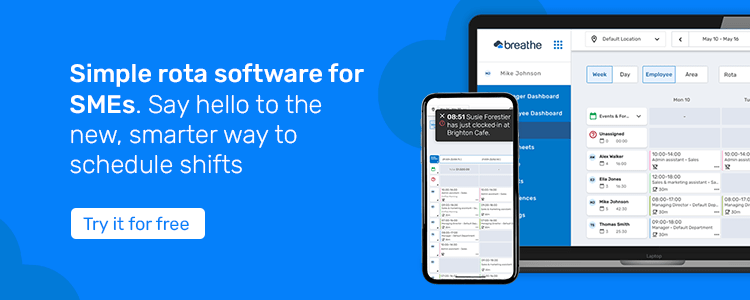Once lockdown restrictions have finally been lifted, many thousands of small businesses will be able to re-open their premises. Pubs, bars, restaurants and hotels in addition to hairdressers and beauty salons have all suffered terribly during the pandemic and for these businesses, the reopening can’t come soon enough.
Having largely been deprived of eating out and visiting pubs and bars, people are expected to flock back to venues, many of which will busier than ever. This is good news for these businesses, owners and employees in addition to the wider UK economy.
But with the reopening will come many challenges for business leaders. In this article we explore. We also discuss steps business leaders can take to reduce time-consuming admin so they can focus on other areas of management and strategic development.
Post-pandemic business challenges
The importance of supporting employees
Adjusting to hybrid working – office based business
Why staggering shift patterns is important
Examples of staggered shift patterns
Effective shift and rota management
Breathe Rota Time and Attendance – putting you in control
Post-pandemic business challenges
The reopening coincides with widespread staff shortages in the hospitality industry with many EU nationals having the left the UK following Brexit.
Significant numbers of UK nationals who previously worked in the hospitality industry have had to switch sectors during the pandemic and may well be happily settled in their new roles. Many employers are now struggling to find replacement staff.
With many people choosing to take holidays in the UK this year, there are also growing numbers of hospitality workers who are finding themselves priced out of hotspots such as Cornwall and having to leave some areas- and their jobs – as a result. Employers are then faced with the additional headache of filling these gaps.
As venues reopen and employers juggle day-to-day management with strategic planning to ensure their business makes a full and rapid recovery, time will be an increasingly precious commodity.
Reducing traditional admin related to people admin can free up time, enabling employers to focus on more strategic areas of their roles including supporting their team members to help with wellbeing and staff retention.
The importance of supporting employees
In Breathe’s 2021 Culture Economy report, we found almost a third (27%) of employees have quit jobs due to poor workplace culture. At a time when employee retention has probably never been so important and key to business recovery, employers need to focus on their people, ensuring their best interests are at the core or run the risk of losing them.
Safeguarding staff who are working in crowded social environments is of paramount importance. Streamlining and managing shift patterns will be key in the coming months and hospitality business owners must think carefully about how to achieve this.
But managing shift patterns doesn’t just apply to businesses in the hospitality and health and beauty sectors. With the widespread adoption of new working practices, other business types are having to follow suit.
Adjusting to hybrid working – office based business
Many SMEs which have traditionally employed an office-based workforce are now implementing new hybrid working models, where employees combine working from home with a phased return to the workplace.
Increasing numbers of people with duties of care may be looking for an extension to flexible working arrangements with which they have been provided with during the pandemic to help them, for instance, with childcare during lockdown.
Managers of businesses which are offering hybrid and flexible working need to know where and when their team members are working and this is why effective shift management is so important.
Why staggering shift patterns is important
The key to planning your businesses return to work is the gradual introduction of staggered shifts, limiting the number of people working together in a reopened workplace at any one time. Although lockdown restrictions may have come to an end, hybrid working looks here to stay.
Staggered shift patterns will also help businesses accommodate different team members and their ongoing need to continue to work from home for at least part of their working week.
A staggered approach will also helps businesses continue to comply with social-distancing rules if they are re-introduced at some point and ease the pressure on public transport at traditional peak times.
Examples of staggered shift patterns
There are various options you can consider as you prepare to implement staggered shifts. Here are some examples:
- Split your staff into teams with alternative days for working from home and the workplace.
- Introduce four in five weeks, where staff work the hours they would in a five day week but spread over four days.
- If staff are in teams, make arrangements for all team members to be in the workplace at any one time.
- Splitting staff into teams with alternate days working from home, or split across day and night shifts.
The Chartered Institute of Personnel Development (CIPD) has published detailed guidance explaining the different types of staggered working hour patterns businesses can consider – this is well worth a read.
Effective shift and rota management
Preparing rotas manually, communicating shift information to employees and accommodating required changes can be time-consuming, especially if managers use pen and paper or Excel.
With the right tools, however, rota management is a seamless process and can be tackled quickly and easily, even if you have no previous shift planning experience.
We have recently released a new module - Breathe Rota Time and Attendance- which automates shift management tasks, making it easy to plan who will be working where and when. This is crucial for managers, ensuring they have adequate cover in place and knowing where there people are at all times.
Breathe's Rota, Time and Attendance module – putting you in control
As with our HR management software, we have focused on making Breathe Rota Time and Attendance easy to use and highly intuitive. It has been developed to save people time, cutting through shift management with ease.
It is ideal for businesses where rota planning is already established and for those where this is a new area of people management.
With Rota, Time & Attendance, you can:
- Build your rota, assign your team & add any events in a flash
- Build & save rota templates to use in future weeks
- Enjoy visibility of the next 30 days' shifts at a glance
- Manage multiple locations
- Generate automatic timesheets with a simple clocking-in tool
- Assign multiple roles to your people
- Effortlessly synchronise your people-data in Breathe HR with your rota
- Keep your team in the loop with handy in-app & email notifications
- Manage upcoming events & forecast salaries
Breathe partner, Rebecca Woolmington, Managing Director of HRCentral Limited comments:
“As the UK moves out of lockdown and businesses reopen, they need an effective way to manage their people.
Whether you are a pub that’s previously used Excel spreadsheets, a business preparing to open or an office that has to operate shifts for the first time, automating this task will save businesses time and hassle – enabling them to focus on rebuilding and growing the business.”

Author: Aimée Brougham-Chandler
An IDM-certified Digital Copywriter (2023) & English Language & Literature graduate (BA Hons), Aimée is Breathe's Content Assistant. With 3 years' content marketing experience, Aimée has a passion for writing - and providing SME HR teams with solutions to their problems. She enjoys delving into & demystifying all things HR: from employee performance to health and wellbeing, leave to company culture & much more.
%20(1)-1.jpg)



